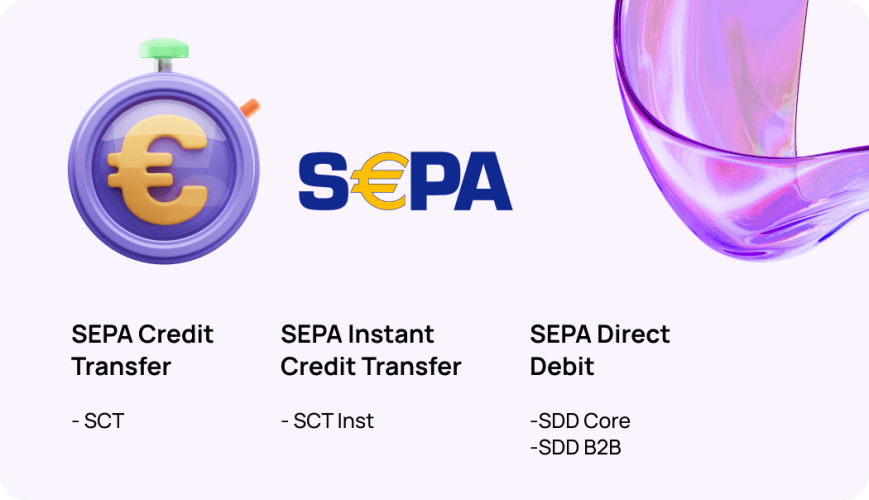SEPA payments: The Smooth Transfers Behind Euro Bank Payments
Discover where SEPA payments work and how to benefit from this payment method.
SEPA payments: The Smooth Transfers Behind Euro Bank Payments
EU consumer and commercial bank account holders are likely acquainted with SEPA. If you live and work outside Europe, you may not have heard of it. But if you own a European company or have EU consumers, you should learn about this payment network used to move cash within 36 nations.
In this article, we discuss what is a SEPA payment system, how it works, and how companies may utilise it to shift money.
What is SEPA?
SEPA (Single Euro Payments Area) aims to streamline cashless payments and standardise EU transactions. The European Payment Council (EPC) regulates SEPA, which facilitates 46 billion transactions annually. SEPA Credit Transfers were launched in January 2008, followed by Direct Debits and debit cards in November 2009.
SEPA, like the US ACH and Fedwire networks, standardise financial institution transactions and offers a common framework for all users. Before SEPA, its member nations were split into national markets, making cross-border euro payments difficult.
Every member state embraced SEPA’s standardised rules, processes, and infrastructure for moving payments. SEPA bank payment area also lowered money movement costs throughout the EU and beyond by removing account transfer obstacles.
Eurozone SEPA payments have improved economies and made life easier for consumers and companies worldwide. As of January 2023, it counts 36 members, including both EU and some non-euro area nations.
Is the UK part of the SEPA payment system?
After the Brexit vote, the UK exited the EU but remained among SEPA payment countries. As long as the UK met conditions, this was allowed in March 2019.
Using SEPA hasn’t altered much for companies, but making payments from the UK to the EU and vice versa requires more information.
Some banks in certain countries have started charging extra for SEPA payment UK transfers, however, this is not common and most UK-EU payments are not subject to additional charges.
Therefore, SEPA still allows UK firms to conduct euro transactions via direct debits or direct credits to other SEPA nations via a single bank account under standardised and cost-effective way.

Is SEPA the same as BACS?
BACS is a UK financial network that transfers cash electronically between banks, particularly for direct debit payments used by subscription companies. Customers authorise the vendor to withdraw money from the bank account at specified intervals automatically.
Typically, BACS direct debits clear in three business days. The process begins with payment data input on the first day, processing by the bank on the second day, and crediting to the vendor’s account on the third day.
The SEPA and BACS direct debit payment processes are similar with the sole distinction that SEPA payments are a Euro payment system between SEPA zone nations, while BACS payments allow UK money transfers.
What is the difference between SEPA and Swift?
In summary, SEPA is a payment system that streamlines bank money transfers in Europe. However, SWIFT (Society for Worldwide Interbank Financial Telecommunication) is a worldwide payment system used to transfer and receive money.
Using SEPA or SWIFT for euro transfers inside Europe doesn’t matter for many users, including company owners. But there are some nuances:
- Since 2011, the U.S. State Department has overseen all payments via the SWIFT system, which was created by Belgian law. However, European tax officials monitor payments using the intra-European SEPA system.
- SWIFT transmits money using bank data and BICs, whereas single euro payment area SEPA is quick, easy, and simple.
- SEPA transactions cost less than SWIFT.
- SWIFT accepts numerous currencies, however, SEPA only accepts the euro.
Therefore, if you want to pay in Europe, use SEPA. If you need to transmit money abroad, utilise SWIFT.
What is the difference between SEPA and bank transfer?
Sending a domestic or cross-border SEPA transfer to any SEPA nation is free and takes one working day. The typical overseas bank transfer (non-SEPA) takes 4–5 business days. This wait may be longer depending on the jurisdiction, beneficiary bank, and intermediate bank. SWIFT interbank network charges make non-SEPA foreign credit transfers more expensive.
Sending, receiving, and exchanging transfers may include costs that vary by bank.
Do you need a SEPA account for your business?
Businesses may handle SEPA euro payments without a bank account. SEPA payment method is a mechanism utilised by banks in member nations, not a financial institution. If you have an IBAN and your business bank account is in a SEPA member nation, you may use the SEPA network and its products.
Businesses outside SEPA member nations, such as those in the US, may be allowed to utilise certain SEPA consumer transaction features for payments from SEPA consumers.

Should non-SEPA enterprises establish European business bank accounts? It depends. An IBAN and local bank account may make sense if your firm has European subsidiaries or operates in SEPA member nations. With a SEPA bank account, you can get SEPA Credit Transfers, Instant Credit Transfers, and cheap European cash withdrawals.
Transferra can serve as your reliable gateway to swift, dependable, and straightforward SEPA payments. With our payment service, transferring funds across Europe is streamlined and secure. Opting for Transferra minimises the inherent risks associated with money transfers within Europe, as well as also assures that there are no hidden fees.
Register your account today, receive your dedicated IBAN accounts and start sending SEPA payments with confidence by avoiding unnecessary currency conversions.

